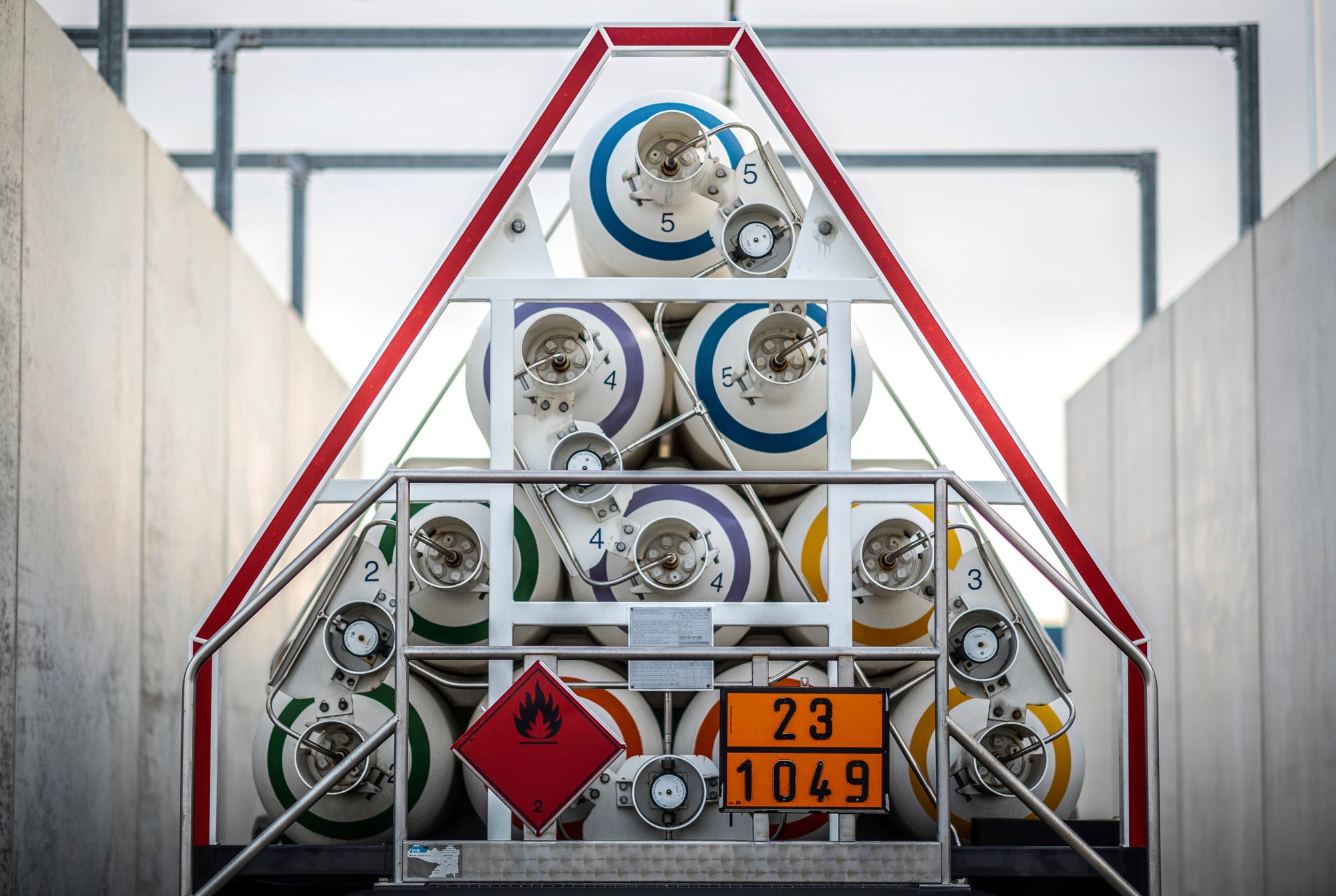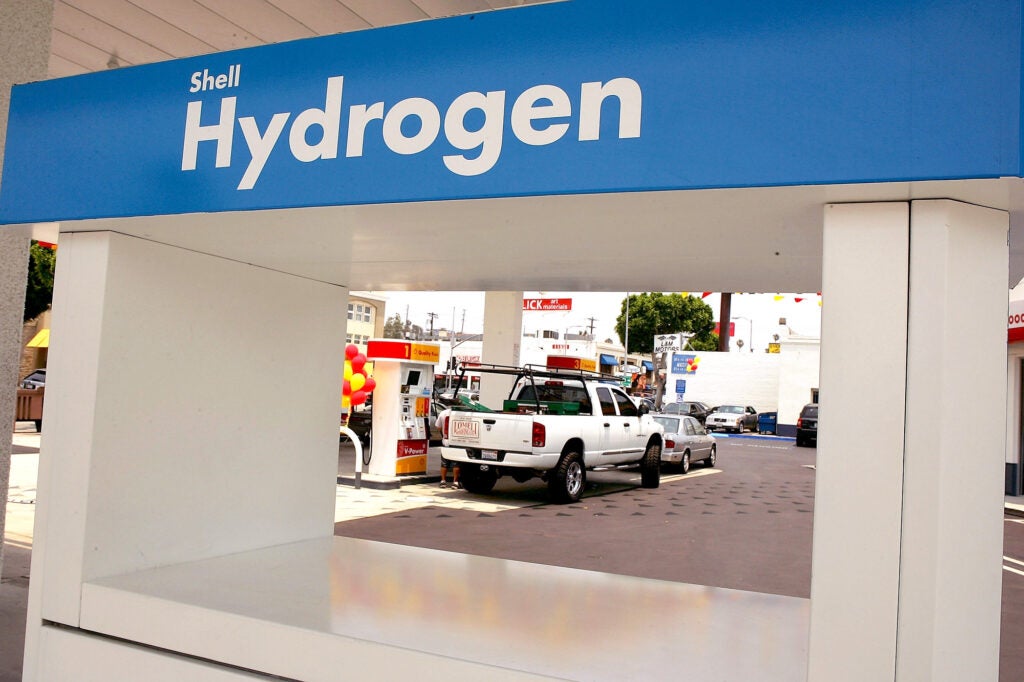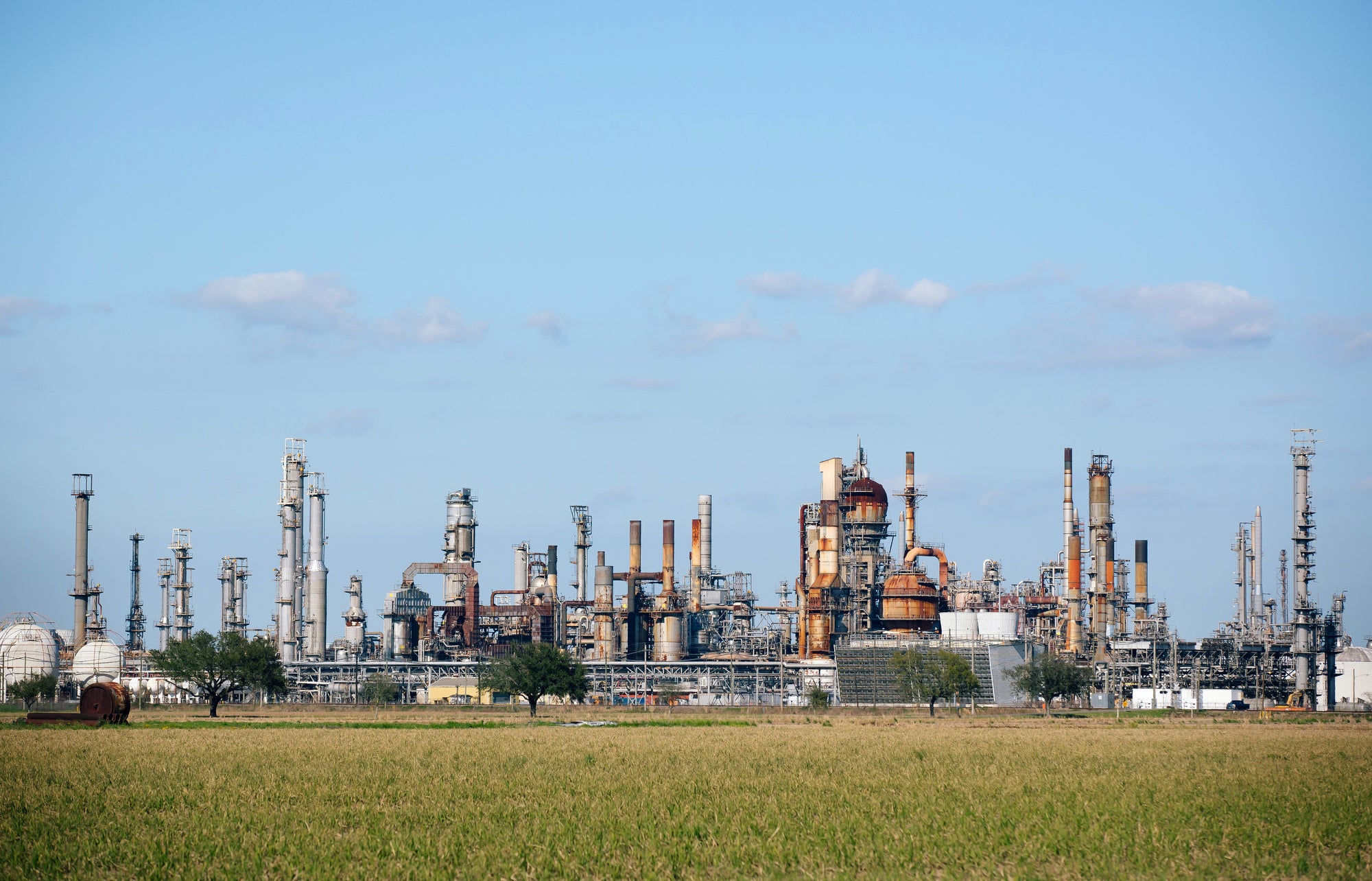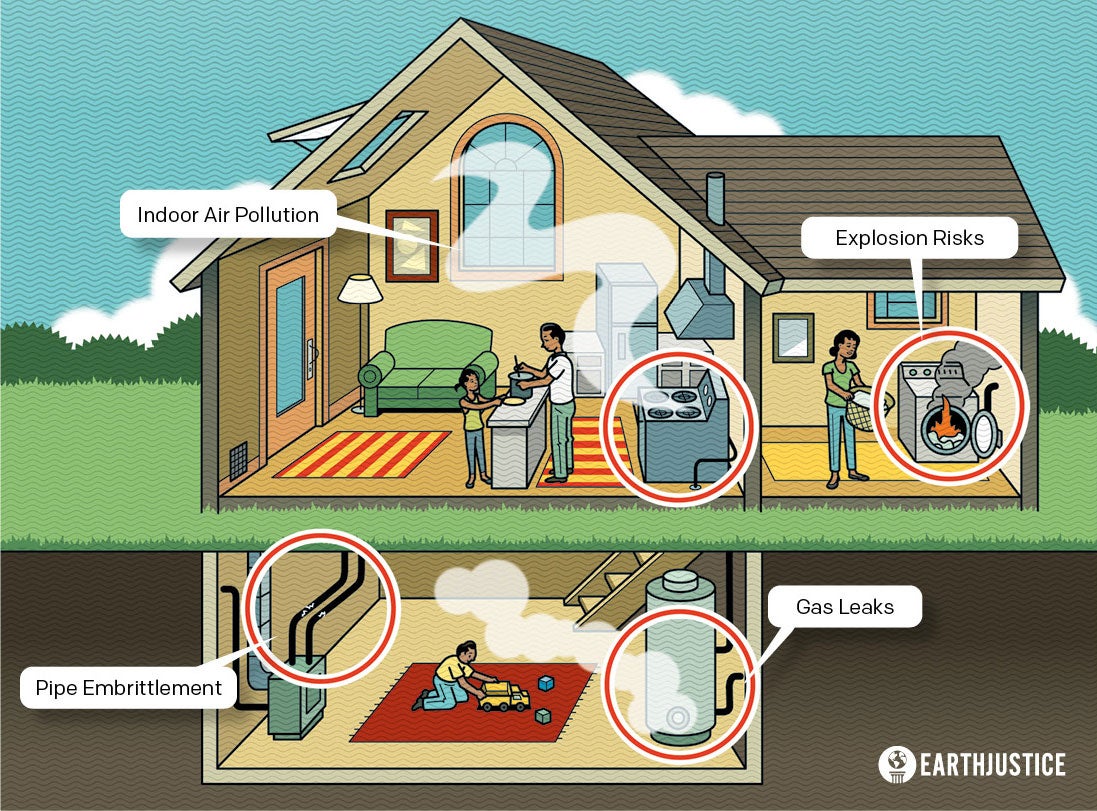October 13, 2023
How Dirty Hydrogen Projects Threaten Our Climate and Health
What you need to know about hydrogen, and how Big Oil and Gas is hyping it up to delay our transition to a clean future.

Oil and gas companies would like us to believe that hydrogen fuel is an up-and-coming clean energy savior. Concerningly, that hype is proving alluring for some policymakers — and it’s distracting them and diverting resources just as we should be accelerating the shift to healthy zero emissions solutions.
Congress has created generous subsidies for hydrogen projects. In October 2023, the Department of Energy announced that seven hydrogen hubs will receive $7 billion in Bipartisan Infrastructure Law funding. Congress also established an estimated $13.1 billion in hydrogen production tax credits in the 2022 Inflation Reduction Act.
There’s a risk that this firehose of funding will flow toward industries building polluting infrastructure, under the guise of vague and unproven claims about hydrogen.
Climate experts and environmental justice communities are urging the federal government to ensure strict environmental integrity in funding for hydrogen projects. But the fossil fuel industry is lobbying to lavish billions in taxpayer dollars on hydrogen projects that pose a major threat to the climate and public health.
The oil and gas industry is hyping up hydrogen in sectors where we already have superior clean energy alternatives.
We should follow through on the transition to clean electricity and modern electric vehicles and appliances, rather than get distracted by the fossil fuel industry’s hydrogen gamble.
So let’s clear some things up.
Hydrogen is the most abundant element in the universe. Pure hydrogen can be used as a fuel because it releases energy when combined with oxygen. However, hydrogen tends to attach to other kinds of molecules, so pure hydrogen is not naturally occurring on Earth. The most common way to produce hydrogen is to separate it from methane gas using extremely high heat and pressure.
This process is called steam-methane reformation (SMR), and it is heavily polluting. The heat comes from burning fossil fuels, which emit harmful pollutants like particulate matter and nitrogen oxides — gases that create smog and can damage your lungs.
Hydrogen isn’t our climate future — it's our dirty present, posing a major threat to our climate and our health. Hydrogen’s climate toll is so huge that global hydrogen production today is responsible for more climate pollution than the entire country of Germany.
Petrochemical companies and oil refineries are responsible for producing nearly all of the United States’ annual supply of hydrogen (about 10 million metric tons).
The process the industry uses to produce this hydrogen air pollution into neighboring communities and pumps climate pollution into our atmosphere.
Many steam-methane reformation facilities are sited in communities already living in the shadow of oil and gas infrastructure.
For instance, the oil refining company Philips 66 recently entered an agreement with gas giant Linde to build what will be the largest hydrogen production facility in the United States. The project is being constructed in St. James Parish, Louisiana, where the concentration of petrochemical plants and refineries has already raised cancer rates so high that the area is known as “Cancer Alley.”
Hydrogen is highly flammable and prone to leaking. Hydrogen burns more rapidly than natural gas, often with explosive outcomes. When leaked into the atmosphere, hydrogen can also have a greenhouse gas effect five times more potent than CO2.
Hydrogen has no place in our homes.
Contrary to spin from gas companies, hydrogen should never be used to replace gas in home appliances such as furnaces, stoves, and water heaters. That would be dangerous, leaky, and irresponsible.
Burning hydrogen in home appliances would produce health-harming air pollution like nitrogen oxides (NOx), the main ingredient in smog, in our homes.
Nitrogen oxides are a family of poisonous, highly reactive gases. They form when fuel is burned at high temperatures — and hydrogen burns at a much higher temperature than the methane gas conventionally used in furnaces and stoves. Nitrogen oxides are a threat to human health because they trigger breathing and lung problems in people.
Children are especially vulnerable to air pollution like nitrogen oxides because they have smaller airways, their lungs are still developing, and they breathe at a faster rate than adults leading them to take in more polluted air.
Injecting hydrogen into our gas system could also create safety hazards in our pipelines and household appliances. Today’s gas lines and pipes were not designed for hydrogen, which can embrittle certain metals used in pipes and sealants and make them more likely to crack.
Households deserve modern upgrades with electric appliances like two-way heat pumps, induction stoves, and electric hot water heaters. These healthy, zero emissions appliances are available today, will help clean the air in our homes, and are far more energy efficient.
Take for example a two-way heat pump, which uses electricity to move heat from a cool space to a warm space — thus warming cool spaces and cooling warm spaces. By transferring ambient heat rather than burning a fuel to create heat, electric heat pumps are up to three times more efficient than a gas furnace.
Hydrogen has no place in our homes. Contrary to spin from oil and gas companies, burning hydrogen in home appliances designed for fossil gas risks polluting the air in our homes, embrittled pipes, leaks from gas lines, and explosions.
Fossil fuel companies know that if they can convince the public and policymakers to use hydrogen produced from fossil fuels (“dirty hydrogen”), they can create a huge new source of demand for their product and keep polluting, even as a transition to 100% clean energy becomes more urgent — and more affordable — than ever before.
In other words, they hope we won’t notice that a hydrogen build-out serves their interests, not ours.
Oil and gas companies will also use hydrogen as a talking point to justify building infrastructure like pipelines that will be used for gas today, and might, the companies argue, be used for hydrogen at some point in the nebulous future.
Oil and gas companies know that it’s no longer politically possible to question climate change, so they’re switching tactics. The confusion they generate furthers climate delay rather than climate action, allowing them to continue polluting for decades to come.
There are clean energy options available today, like electric vehicles and appliances, that offer communities a path to getting fossil fuels out of our homes altogether. But by shifting the conversation and massive public investments to hydrogen, the oil and gas industry can hinder our transition to an electric future.
Hydrogen is rarely a solution for vehicle pollution, except possibly in extremely niche transportation sectors we can not otherwise easily electrify. In nearly every case, electric vehicles are a better option than hydrogen models, especially when it comes to cars.
Hydrogen fuel cells cost much more and are far less efficient than battery-electric cars. Hydrogen cars also guzzle up a lot more renewable electricity than modern electric vehicles, which can be plugged right into the energy grid.
In contrast to an electric car, you would need two to three times as much renewable energy to power a hydrogen car. This is one reason hydrogen would be much more expensive than directly charging with clean electricity in a carbon-free economy, and risks wasting our still-growing amount of renewable energy to displace less fossil fuel.

A pickup truck fills up with gasoline near a hydrogen fuel pump at the first hydrogen refueling station in Los Angeles. (David McNew / Getty Images)
To protect our climate and future, we need ambitious efforts to electrify our transportation sector wherever we can, as quickly as we can. This is the way we will see the climate gains we need this decade. Thankfully, states on both coasts are advancing bold policies to electrify everything on wheels, from cars and public transit buses to heavy-duty trucks and trains.
Hydrogen types can be categorized most simply as either dirty hydrogen that uses methane gas to create fuel, and clean (or “green”) hydrogen, which is produced through 100% renewable energy to split hydrogen off water molecules. Less than 1% of the hydrogen produced today is clean.
You’ll primarily hear hydrogen coded in three color categories of gray, blue, and green. Gray and blue hydrogen are just different ways of producing hydrogen from fossil fuels. To learn more, read our hydrogen report.
It’s time to move into an electric future and deploy the zero emission, nonpolluting solutions available now. We already have the tools we need to run our transportation systems and homes on renewable energy, and now it’s time to build an electric future.
Policymakers should look under the hood of any hydrogen projects, especially those proposed by oil and gas companies. In many cases, proposed hydrogen projects would dirty our air, destabilize the climate, and delay climate action. Despite the hype, hydrogen should play a carefully limited role in our climate future.
To help stop the fossil fuel industry’s hydrogen hype, share this information with your friends and learn more by reading our report, “Reclaiming Hydrogen for a Renewable Future.”

Right to Zero is transforming the way we use energy and transport goods, services and ourselves. From our power grid to ports, buses to garbage trucks, it’s time to ditch fossil fuels and lead the shift to zero-emissions. Earthjustice is fighting for zero to save lives, protect our climate and strengthen our economy. We won’t just imagine a zero-emissions future. We will live it.
